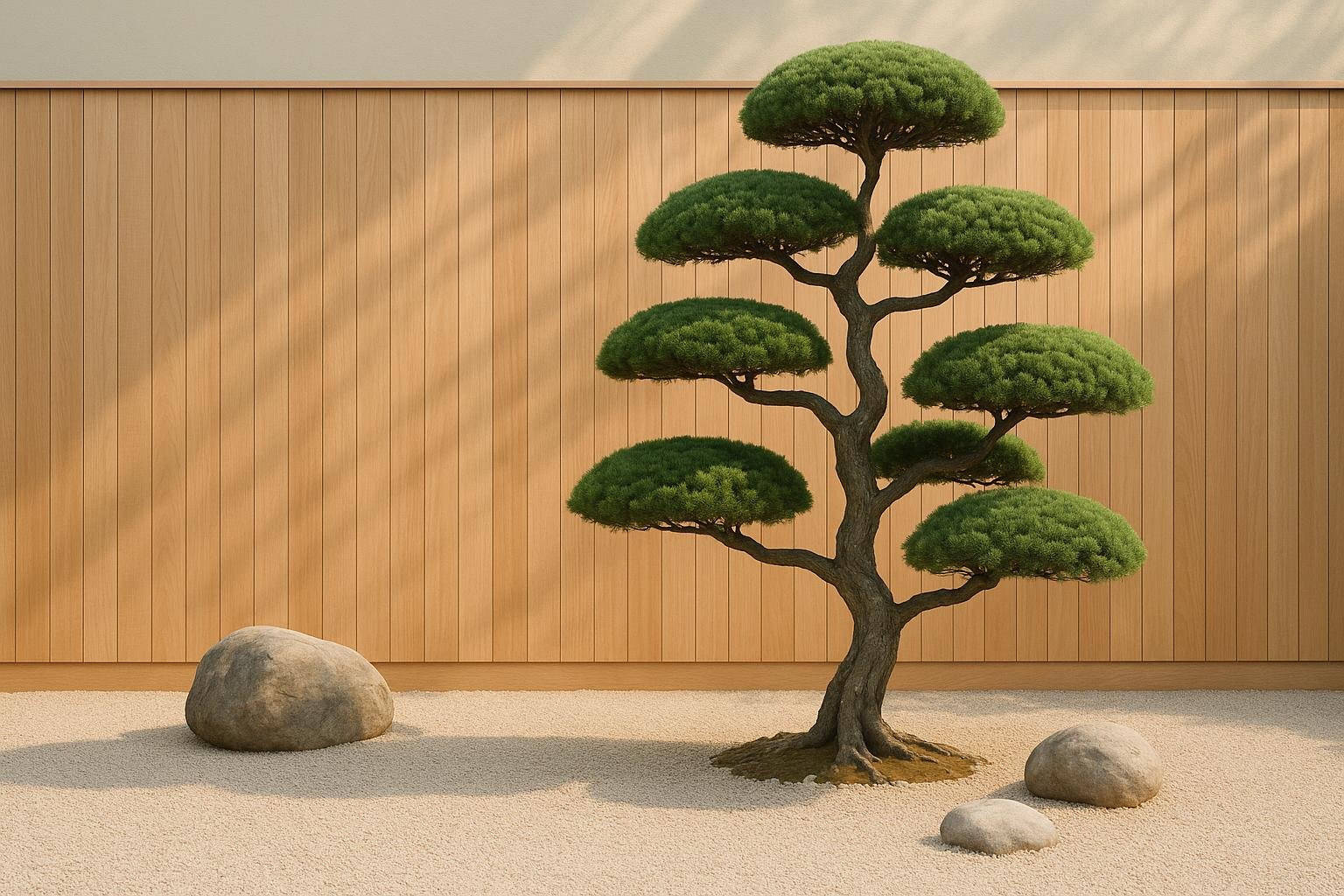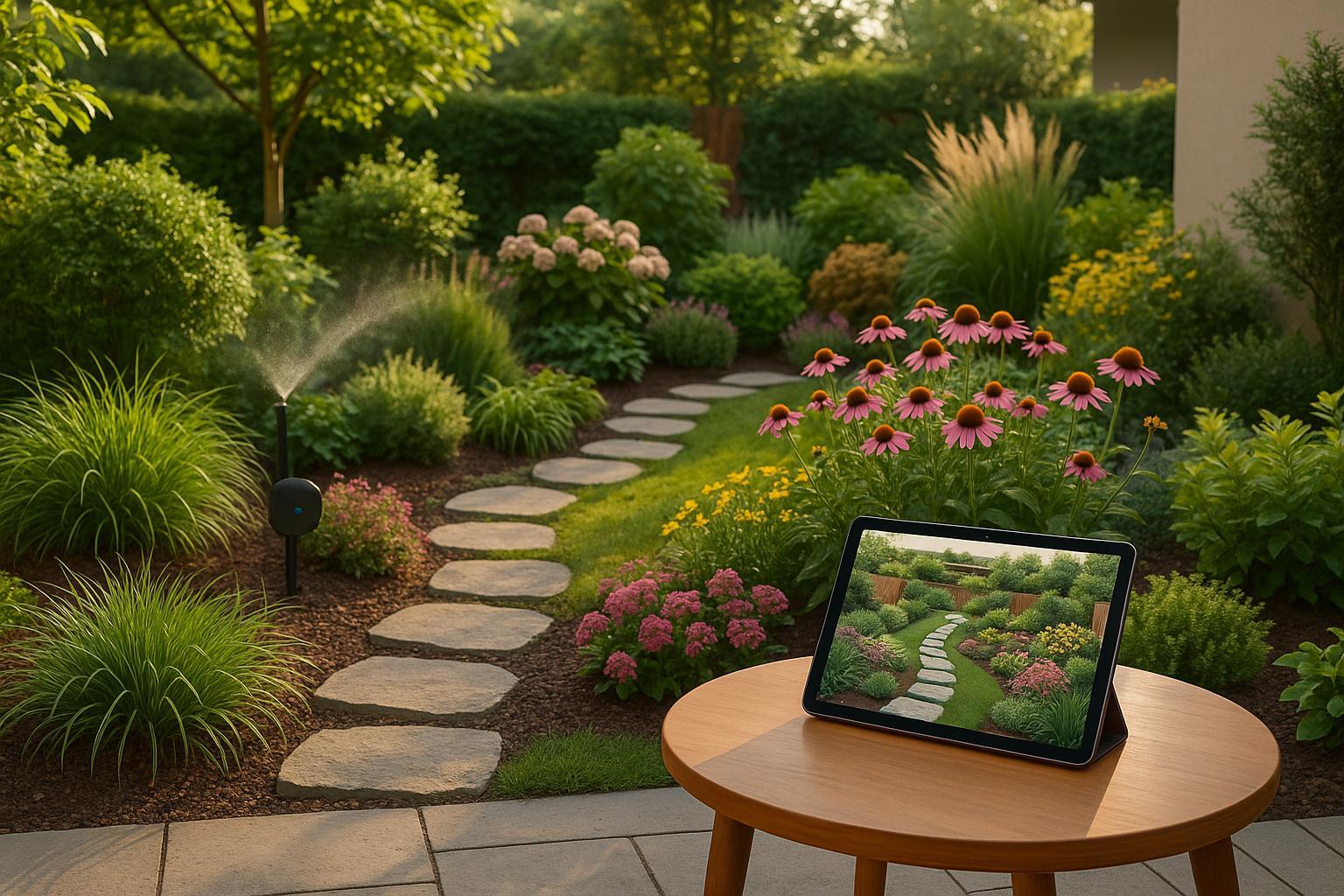Niwaki Pruning for Minimalist Gardens

Niwaki pruning is the Japanese art of shaping full-sized trees into elegant, sculptural forms that highlight their natural beauty. Unlike bonsai, which focuses on small potted trees, niwaki works with in-ground trees and emphasizes simplicity, balance, and intentional design. Here's a quick overview of what you need to know:
- Why Niwaki? Perfect for minimalist gardens, niwaki creates striking focal points with fewer elements, making it ideal for modern, small spaces.
- Best Trees for Niwaki: Japanese Black Pine, Boxwood, Japanese Holly, Yew, and Japanese Privet are popular choices. Each has unique pruning needs and thrives in specific USDA zones.
- Key Techniques: Focus on removing dead or overcrowded branches, thinning, candle pruning for pines, and shaping for balance and openness.
- Timing: Prune in early to late summer for maintenance and in spring for major shaping.
- Care Tips: Seasonal maintenance, proper tools, and pest management are essential for healthy, sculpted trees.
Niwaki pruning transforms ordinary trees into living works of art, blending nature with minimalist design. Whether you're starting with a single tree or planning an entire garden, niwaki adds character and tranquility to your outdoor space.
Pruning 'Niwaki' Japanese Garden Trees

Selecting Plants for Niwaki
Choosing the right plants is essential when creating niwaki, as the process involves hard pruning to shape plants into striking, minimalist forms. Not all species can handle this kind of training, so selecting plants that thrive under these conditions is key to achieving the desired sculptural, weathered look often seen in Zen gardens. Below are some of the best plant options for niwaki shaping in U.S. gardens.
Best Plants for Niwaki Shaping
Certain plant species stand out as ideal candidates for niwaki pruning. They not only tolerate regular shaping but also improve in structure and form over time, making them perfect for minimalist garden designs.
Evergreens are a popular choice because they maintain their sculptural appeal throughout the year. A classic example is the Japanese Black Pine (Pinus thunbergii), which requires candle pruning to develop its iconic shape. Be sure to check the hardiness of specific cultivars for your USDA zone.
Boxwood (Buxus sempervirens) is another excellent option, thriving in zones 5–9. It responds well to frequent trimming, producing dense, compact growth that's ideal for artistic shaping. Horticulturist Michael Dirr describes its appeal:
Each one becomes a unique individual, forming a mounding, irregular bush of great charm.
For a boxwood alternative, consider Japanese Holly (Ilex crenata). This plant features similar fine texture and compact growth but has slightly different growing requirements. It thrives in zones 6–8 and adapts well to niwaki techniques.
Yew (Taxus baccata) is another standout for its ability to handle heavy pruning. Hardy in zones 6–8, it remains healthy even with aggressive shaping, making it a reliable choice for niwaki.
If you're looking for faster results, Japanese Privet (Ligustrum japonicum) grows quickly and provides rapid coverage. However, it requires more frequent trimming to maintain its shape, making it better suited for gardeners who don't mind the extra upkeep.
| Plant Species | Suitability for Niwaki | USDA Zones | Notes |
|---|---|---|---|
| Japanese Black Pine (Pinus thunbergii) | High | Varies by cultivar | Requires candle pruning |
| Boxwood (Buxus sempervirens) | High | 5–9 | Great for formal shapes |
| Japanese Holly (Ilex crenata) | High | 6–8 | Alternative to boxwood |
| Yew (Taxus baccata) | High | 6–8 | Handles heavy pruning well |
| Japanese Privet (Ligustrum japonicum) | Medium | 7–10 | Fast-growing; needs frequent trimming |
Plant Selection Factors
In addition to choosing the right species, other factors like growth rate, climate suitability, and maintenance needs play a role in achieving a successful niwaki design.
Growth rate is an important consideration. Slower-growing plants, such as boxwood and yew, require less frequent pruning, while faster growers like Japanese Privet offer quicker results but demand more regular attention.
Plant size at purchase affects both cost and flexibility. Smaller plants are more affordable and allow for greater artistic freedom as you train them from the start. However, it takes time to achieve a mature look. On the other hand, larger specimens provide immediate visual impact and align with the minimalist principle of using "one or two mature trees rather than several small ones". The trade-off is a higher initial cost and less flexibility in shaping established branches.
Climate adaptation is crucial for healthy growth and easier maintenance. Choose plants suited to your USDA hardiness zone and local soil conditions. For example, sandy or clay soils common in many areas can influence plant performance, so selecting species that thrive in these conditions is essential.
Sunlight requirements also vary among niwaki candidates. Some plants thrive in full sun, while others prefer partial shade. Observing your garden's sun exposure throughout the day will help you determine the best planting spots.
Finally, maintenance is an ongoing consideration. Most niwaki plants benefit from annual pruning with tools like secateurs or shears, typically done in early or late summer. If you're unsure about which plants are best for your area, consulting a certified arborist can provide valuable guidance tailored to your local climate and soil conditions.
How to Prune Niwaki Style
Once you've chosen the right plants, the next step is to shape them into captivating works of art. Pruning in the niwaki style is both a technical and creative process, requiring a keen eye for detail and a steady hand. The goal? To transform ordinary trees into elegant, sculptural features that embody the simplicity and balance of Japanese garden design. This involves carefully assessing the tree's structure, applying specific pruning techniques, and timing your efforts for the best results.
Evaluating Tree Structure
Start by examining your tree's natural form. The first step is to identify and remove anything that detracts from its aesthetic or health. Pay attention to:
- Dead branches: Snip away any brittle, lifeless branches that show no signs of growth. This not only improves the look but also helps prevent disease.
- Damaged or diseased branches: Cut off branches that are broken or discolored to maintain the tree's health and visual appeal.
- Overcrowded areas: Thin out dense sections to create open spaces, allowing each branch to stand out as part of the overall design.
This process of selective removal lays the groundwork for shaping the tree into a minimalist, balanced form - a hallmark of Japanese garden aesthetics.
Core Pruning Methods
Once you've evaluated the structure, it's time to shape the tree using three key techniques:
- Branch Thinning: Remove inner branches to open up the tree's framework. This lets in more light, encourages healthy growth, and creates the negative space essential to Japanese garden design.
- Candle Pruning: This technique is vital for conifers like Japanese Black Pine. It involves pinching or trimming the soft, new growth (known as "candles") by about half to two-thirds of their length while they're still pliable. Timing is critical - this should be done when the new growth is soft and flexible.
- Tip Reduction: Trim new vertical growth down to one or two buds. For broadleaf trees, this creates paddle-shaped branch tips, while for smaller plants, branches should be pruned to about 12 inches from the trunk to encourage a denser, more compact form.
When to Prune
Timing plays a crucial role in niwaki pruning. Different tasks should be done at specific times of the year to ensure the best results:
- Early to Late Summer: This is the ideal window for maintenance pruning, after the spring growth spurt but before winter sets in.
- Spring: Major structural pruning is best done in spring when branches are still flexible. Use natural fiber string to train side branches at a slight downward angle, around 10° below horizontal.
- Late Spring to Early Summer: For pines, prune the soft, new candles during this period, before they harden.
For long-term upkeep, plan annual pruning sessions to maintain the tree's shape and health. Hand-pruning with secateurs is especially effective for plants with larger leaves, as it avoids the rough edges that shears can leave behind.
Lastly, always use clean, sharp tools to minimize damage. Well-maintained secateurs, snips, and saws make precise cuts, ensuring the tree stays healthy and looks its best.
sbb-itb-4d6a8dd
🚀 Ready to Reinvent Your Garden?
Join thousands of homeowners who have transformed their gardens using our AI design tool. Upload one photo to explore endless possibilities.
Get your AI garden designs →Caring for Your Niwaki Trees
Keeping your niwaki trees healthy and maintaining their elegant shapes requires consistent care throughout the year. Unlike standard pruning, niwaki care blends tree health with preserving its artistic form. This ongoing effort ensures your minimalist garden stays tranquil and visually balanced while your trees flourish year after year.
Year-Round Care Schedule
Each season brings specific tasks to support both the health and aesthetics of your niwaki trees. By following a seasonal care routine, you can address potential problems early and maintain the precise shapes that define this Japanese gardening art.
Winter
Winter is the best time for major structural pruning on deciduous trees. With the leaves gone, you get a clear view of the tree’s framework, making it easier to decide which branches to keep or remove. Mulch the root zones to protect against temperature swings, and water young or newly planted trees during dry spells, especially before hard freezes. Remove crossing branches to prevent future structural problems.
Spring
Spring is all about renewal and inspection. Check your trees for signs of winter damage, pests, or diseases that may have appeared during dormancy. Fertilize your trees and establish a consistent deep-watering routine as growth picks up. If you have flowering niwaki, time your pruning carefully to avoid cutting off developing flower buds.
Summer
Summer care focuses on watering and maintenance pruning. As temperatures climb, water your trees more frequently. Early or late summer is the ideal time for annual pruning, using secateurs or shears to maintain the tree’s shape. Stay vigilant for pests and diseases, addressing any signs of trouble immediately. Remove damaged or hazardous branches that may result from summer storms.
Fall
Fall is a season for planting and preparation. Cooler weather and increased rainfall make it a great time to add new trees to your niwaki collection. Clear fallen leaves from the area and continue watering your established trees to prepare them for dormancy. Inspect for potential hazards or structural issues before winter arrives. Mulch around the base of the trees to insulate roots and retain moisture through the colder months.
Solving Common Problems
Even with diligent care, niwaki trees can encounter challenges. Addressing issues early helps maintain both their health and their sculptural beauty.
Pest and Disease Management
From early April onward, warmer weather brings increased pest activity. Regular inspections are your best defense. For long-term protection against piercing-sucking insects, consider systemic insecticides applied via soil injections, which are less labor-intensive than repeated foliar sprays. If fungal diseases are a concern, use fungicides designed for specific problems like apple scab, arborvitae twig blight, or cherry tree brown rot, applying treatments at recommended intervals.
Overgrowth Issues
Overgrowth can disrupt the carefully crafted forms of niwaki trees, especially in fast-growing species that may need more frequent trimming. Pay close attention to the tree’s upward growth, as it can undo the horizontal tray-like formations typical of niwaki styling. Regularly remove vertical shoots to preserve the desired shape.
Tool Selection and Recovery
Using the right tools is essential for precise pruning. Always choose sharp, professional-grade tools to minimize damage and ensure clean cuts. For trees with larger leaves, hand pruning with secateurs is better than shears, which can leave unattractive cuts on broadleaf species . Tools like Tobisho and Okatsune secateurs are excellent choices for detailed work. Keeping your tools sharp and clean not only promotes faster healing but also reduces the risk of spreading disease.
If your tree’s shape is compromised, recovering its original form takes time. Patience is key when rehabilitating overgrown or damaged trees. In severe cases, consulting a certified arborist can help identify underlying issues and implement effective solutions before they worsen. Tackling problems early is always easier than correcting major structural damage down the line.
Adding Niwaki to Your Garden Design
Once you've refined and nurtured your niwaki trees, it's time to weave them into your garden's overall design. These meticulously pruned trees can transform your outdoor space into a tranquil retreat, blending artistry with nature.
Creating Design Balance with Niwaki
Incorporating niwaki into your garden is all about achieving harmony through Japanese principles of asymmetrical balance. The natural, irregular shapes and soft curves of niwaki invite a sense of calm and contemplation.
For a dynamic and engaging layout, group niwaki trees in odd numbers - such as three, five, or seven - and vary their sizes. Partially concealing them creates layers of intrigue and shifting perspectives. Enhance the scene with traditional Japanese elements like stone lanterns, bamboo fences, or water features. Pathways can be strategically placed to draw visitors toward these focal points, while the concept of shakkei (borrowed scenery) frames the niwaki within the broader landscape, blending your garden with its surroundings.
Evergreens, such as pines and hollies, provide consistent beauty throughout the year, while deciduous trees like Japanese maples bring bursts of seasonal color and contrast. To maintain balance, focus on proportionality - select one or two mature, striking trees rather than crowding the space with multiple smaller specimens. This approach ensures harmony with other garden features, such as seating areas or walkways.
To further enhance the tranquil aesthetic, opt for minimalist outdoor furniture. Simple designs with clean lines and natural materials complement the peaceful vibe of a niwaki-centered garden. By following these principles, every element of your garden can contribute to a cohesive and serene design.
Using AIGardenPlanner for Planning

Once you've sketched out your vision, bring it to life with the help of AIGardenPlanner. This AI-powered tool takes a photo of your garden and transforms it into a detailed design, allowing you to visualize niwaki placements and refine spatial arrangements with ease. With access to over 50 garden styles - or the option to create your own - you can seamlessly integrate Japanese and minimalist design elements.
AIGardenPlanner also provides plant recommendations tailored to your location, climate, and gardening goals, ensuring your chosen trees thrive. Its advanced project management features let you experiment with different niwaki arrangements and pruning styles. Ultra HD visuals give you a clear picture of your design, making it easier to fine-tune every detail before making changes to your garden.
Pricing starts at $15 per project, with a Starter plan available for $9 per month (billed annually). As the AIGardenPlanner team puts it:
"Our AI doesn't just change your garden – it revolutionizes it. With complete control over every aspect, from targeted garden makeovers to full property transformations."
This iterative approach lets you test various layouts and styles, ensuring your garden achieves the serene, balanced aesthetic that defines niwaki-inspired minimalist spaces.
Conclusion
Niwaki pruning transforms minimalist gardens by bringing out the unique character of each tree and fostering a sense of harmony. This ancient Japanese practice is more than just tree maintenance - it's an art form that reveals a tree's essence and integrates it seamlessly into the surrounding landscape. These principles are at the heart of niwaki's enduring appeal.
Key Takeaways About Niwaki Pruning
Niwaki pruning highlights a tree's natural beauty through deliberate shaping. By focusing on asymmetry, simplicity, and depth, it creates trees that look both sculptural and timeless, perfectly suited for minimalist gardens.
One of the most fascinating aspects of niwaki is its ability to make trees appear older and more weathered than they really are, adding an instant sense of maturity and character to any space. The technique also emphasizes a clean, open structure, with branches arranged in tiered layers that allow light and air to flow freely through the canopy. As Jake Hobson, a leading voice in niwaki pruning, puts it:
A tree well pruned can express more than a tree can express naturally.
This method creates miniature landscapes within your garden, blending balance and simplicity with the tree's natural growth patterns. These principles align perfectly with the goals of minimalist garden design, where every element contributes to a cohesive and tranquil environment.
Starting Your Minimalist Garden with Niwaki
Ready to bring niwaki into your garden? Start with patience, practice, and a few essential tools. Choose plants like Box, Yew, Pine, or Japanese Privet, and focus on removing unnecessary branches while keeping the base of the tree clean. Keep in mind that shaping a tree into its ideal form is a gradual process that unfolds over years.
Begin with simple techniques to achieve the airy, open structure that defines niwaki. A good rule of thumb? The tree should be open enough for a bird to fly through without brushing against the leaves.
For those looking to plan their garden with precision, AIGardenPlanner can be an invaluable tool. This platform allows you to visualize niwaki placements, experiment with layouts, and explore over 50 garden styles. It also provides plant recommendations tailored to your climate and growing conditions, ensuring your trees thrive.
With the help of AIGardenPlanner and the timeless art of niwaki, you can transform any outdoor space - whether a small urban garden or a sprawling property - into a serene retreat that celebrates natural beauty and thoughtful design.
FAQs
What tools do I need for niwaki pruning, and how should I care for them?
When it comes to niwaki pruning, having the right tools is key. You'll need secateurs, shears, and a pruning saw to get the job done effectively. But keeping these tools in excellent condition is just as important as using them.
After each use, make sure to clean your tools thoroughly to remove sap and debris. This helps prevent buildup that can dull the blades. To ward off rust, use a rust eraser or a similar product, and keep the blades sharp with a whetstone - sharp tools make for cleaner, more precise cuts. Once cleaned, apply a light layer of camellia oil to the metal parts. This not only protects them from corrosion but also ensures they work smoothly.
Another essential step? Disinfect your tools. This prevents the spread of diseases between plants, which is crucial for maintaining healthy growth. Taking the time for regular maintenance doesn’t just prolong the life of your tools - it also makes your pruning efforts more effective and satisfying.
What is niwaki pruning, and how is it different from bonsai? Why is it ideal for minimalist gardens?
Niwaki pruning is the art of shaping larger trees planted directly in the ground, offering a distinct contrast to bonsai, which focuses on cultivating miniature trees in containers. While bonsai seeks to mimic the look of full-sized trees on a smaller scale, niwaki enhances the tree's natural form to create a seamless connection with its surrounding landscape.
This technique works beautifully in minimalist gardens, as it highlights simplicity, balance, and clean lines. Niwaki trees bring sculptural elegance to a space without dominating it, creating an atmosphere of calm and refinement that complements Zen and meditation garden designs perfectly.
How can I use niwaki pruning to create a minimalist and balanced garden design?
To design a minimalist and harmonious garden with niwaki trees, pay close attention to their shape, placement, and pruning style. Start by selecting tree species that align with your garden's overall vibe. Use pruning techniques like cloud pruning to emphasize their sculptural elegance, turning them into eye-catching focal points that enhance the clean, minimalist aesthetic.
Spacing is crucial - give each tree enough room to grow to its full size without crowding, while keeping the layout visually balanced. To complement the niwaki trees, consider adding companion plants that reflect similar colors and textures. This pairing creates a peaceful, unified atmosphere, ideal for Zen or meditation gardens. With careful planning and thoughtful pruning, your garden can become a serene retreat that feels perfectly in balance.
🎨 Visualize Your Dream Garden Today!
Transform any outdoor space into a professional landscape design in minutes. Just upload a photo, choose your style, and let our AI do the rest.
Start your garden transformation now →Related posts
Related Articles

Top 5 AI Features for Garden Design
Explore how AI is revolutionizing garden design, offering personalized styles, plant recommendations, and maintenance forecasting for every gardener.

Spring Garden Planning Checklist: Essential Steps for Success
Prepare your garden for spring with essential steps, including soil testing, tool maintenance, and planting schedules for a thriving season.

AI Garden Planners vs. Traditional Methods
Explore the differences between AI garden planners and traditional methods, highlighting their strengths, limitations, and how they can complement each other.

Top 5 Data Compression Methods for IoT Sensors
Explore the top five data compression methods for IoT sensors in garden monitoring systems, enhancing efficiency, performance, and energy savings.

Revolutionizing Landscaping with AI: Benefits of Using an AI Landscaping App
Discover how AI landscaping apps are transforming outdoor design with precision planning, time-saving features, and a sustainability focus. Learn about the benefits and challenges of integrating AI technology in landscaping projects.

AI Holiday Lighting for Landscapers
Explore how AI is revolutionizing holiday lighting for landscapers, enhancing design efficiency, customization, and client satisfaction.